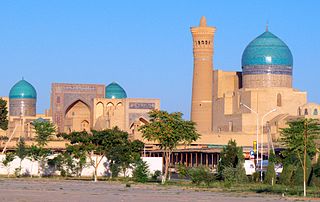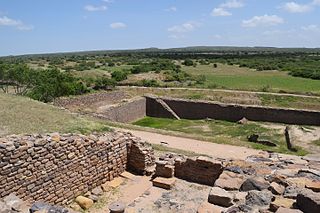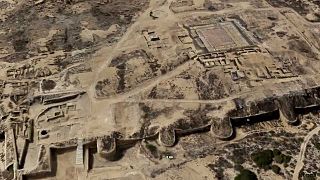Site description
According to the archaeological research, Poykent was founded as a small village in the 4th century B.C., and was later transformed into a fortress. During that period, it was a trade center, as the city connected Southern countries (Bactria, India, Iran) with Northern countries (Front of Ural, Coast of Volga, Northern Caucus). Poykent was one of the important military and trade centers of the Western borders of the Sogd. Due to the development of the Great Silk Road and joining with Poykent fortress have been founded first and second sites of ancient settlement. Hence the city Poykent was founded.
According to Chinese chronicles, this city was under the "An" (Bukhara) kingdom and was the centre of "Bi" khanate. It has also been noted that in Poykent there was no khokim (governor), the city was ruled by traders' council, and in the full sense of the word the city was a republic in the 6th-7th century. The scientists of Institute of Archaeology of the Academy of Sciences of the Republic of Uzbekistan have carried out scientific research in the ruins of the city for a long time. As a result, Zoroastrian temples, a palace, and a mosque, built in the 9th century, and remnants of a tower were found in citadel. In the inner part of city were discovered defensive walls, a gate, roads, and the remains of [living] quarters (makhallas), while on the outside rabads (suburbs) of the city - there are pottery centers and caravanserais. According to the researcher, due to the inaccessibility of the lower flaw of Zarafshon River, the city ceased to exist in the middle of the 9th century. [1]

A lost city is an urban settlement that fell into terminal decline and became extensively or completely uninhabited, with the consequence that the site's former significance was no longer known to the wider world. The locations of many lost cities have been forgotten, but some have been rediscovered and studied extensively by scientists. Recently abandoned cities or cities whose location was never in question might be referred to as ruins or ghost towns. The search for such lost cities by European explorers and adventurers in Africa, the Americas, and Southeast Asia from the 15th century onwards eventually led to the development of archaeology.

Bukhara is the seventh-largest city in Uzbekistan, with a population of 280,187 as of 1 January 2020, and the capital of Bukhara Region.

Mtskheta is a city in Mtskheta-Mtianeti province of Georgia. It is one of the oldest cities in Georgia as well as one of the oldest continuously inhabited cities in the World. Itis located approximately 20 km (12 mi) north of Tbilisi, at the confluence of the Mtkvari and Aragvi rivers. Currently a small provincial capital, for nearly a millennium until the 5th century AD, Mtskheta was a large fortified city, a significant economical and political centre of the Kingdom of Iberia.
Taraz is a city and the administrative center of Jambyl Region in Kazakhstan, located on the Talas (Taraz) River in the south of the country near the border with Kyrgyzstan. It had a population of 330,100 as of the 1999 census, up 9% from 1989, making it one of the fastest-growing cities in the country, after Astana and Turkistan.

Termez is the capital of Surxondaryo Region in southern Uzbekistan. Administratively, it is a district-level city. Its population is 182,800 (2021). It is notable as the site of Alexander the Great's city Alexandria on the Oxus, as a center of Early Buddhism, as a site of Muslim pilgrimage, and as a base of Soviet Union military operations in Afghanistan, accessible via the nearby Hairatan border crossing.

The Dead Cities or Forgotten Cities are a group of 700 abandoned settlements in northwest Syria between Aleppo and Idlib. Around 40 villages grouped in eight archaeological parks situated in north-western Syria provide an insight into rural life in Late Antiquity and during the Byzantine period. Most of the villages, which date from the 1st to 7th centuries, were abandoned between the 8th and 10th centuries. The settlements feature the well-preserved architectural remains of dwellings, pagan temples, churches, cisterns, bathhouses etc. Important dead cities include the Church of Saint Simeon Stylites, Serjilla and al Bara.

Konye-Urgench, also known as Old Urgench or Urganj, is a city of about 30,000 inhabitants in north Turkmenistan, just south from its border with Uzbekistan. It is the site of the ancient town of Gurgānj, which contains the ruins of the capital of Khwarazm. Its inhabitants deserted the town in the early eighteenth century in order to develop a new settlement, and Konye-Urgench has remained undisturbed ever since. In 2005, the ruins of Old Urgench were inscribed on the UNESCO List of World Heritage Sites.

Bara or al-Bara is one of the former "Dead Cities" in northwestern Syria. It is located in the Zawiya Mountain approximately 65 kilometres (40 mi) north from Hama and approx. 80 km southwest from Aleppo. Al-Bara is also town in Ariha district. According to the Syria Central Bureau of Statistics (CBS), al-Bara had a population of 10,353 in the 2004 census.

Dholavira is an archaeological site at Khadirbet in Bhachau Taluka of Kutch District, in the state of Gujarat in western India, which has taken its name from a modern-day village 1 kilometre (0.62 mi) south of it. This village is 165 km (103 mi) from Radhanpur. Also known locally as Kotada timba, the site contains ruins of a city of the ancient Indus Valley civilization. Earthquakes have repeatedly affected Dholavira, including a particularly severe one around 2600 BC.

The Erbil Citadel, locally called Qelat is a tell or occupied mound, and the historical city centre of Erbil in the Kurdistan Region. The citadel has been included in the World Heritage List since 21 June 2014.

Tushpa was the 9th-century BC capital of Urartu, later becoming known as Van which is derived from Biainili, the native name of Urartu. The ancient ruins are located just west of Van and east of Lake Van in the Van Province of Turkey. In 2016 it was inscribed in the Tentative list of World Heritage Sites in Turkey.
Shahrukhiya is a site of ancient settlement located 88 km to the southwest of Tashkent, Uzbekistan, on the right coast of Syrdarya River. It is the first large city of the Tashkent oases, situated on the Great Silk Road through Yaksart (Syrdarya). In the oriental sources, it was famous under the name Benaket, and the portion of the Great Silk Road direction called by its name.
The site of ancient settlement at Kanka, Uzbekistan, is located in 80 km southeast of Tashkent, in the southeastern outskirts of the Eltamgali settlement. It is one of the large, ancient city centers of the Tashkent oasis. Kanka is the first capital of the Chach state, a small estate of Kanguy.

Erbil, also called Hawler, is the capital and most populated city in the Kurdistan Region of Iraq. It lies in the Erbil Governorate. It has an estimated population of around 1,600,000.

Denov is a city in Surxondaryo Region of southeast Uzbekistan, the administrative centre of Denov District. It is in the Hissar Range close to the border with Tajikistan, and is the closest major town to the Kalchayan and Dalverzin Tepe archaeological sites. Denov is believed to be the site of ancient city of Chaghaniyan.

Banbhore, Bambhore, Bhanbhore or Bhambhore is a city dating to the 1st century BCE located in modern-day Sindh, Pakistan. The city ruins lie on the N-5 National Highway, east of Karachi. It dates back to the Scytho-Parthian era and was later controlled by Muslims from the 8th to the 13th century, after which it was abandoned. Remains of one of the earliest known mosques in the region dating back to 727 AD are still preserved in the city. In 2004, Department of Archaeology and Museums Pakistan submitted the site for UNESCO World Heritage Sites.

Diyarbakır Fortress, is a historical fortress in Sur, Diyarbakır, Turkey. It consists of an inner fortress and an outer fortress.

The Fortifications of Derbent (Darband) are one of the fortified defense lines built by the Persian Sasanian Empire to protect the eastern passage of the Caucasus Mountains against the attacks of the nomadic peoples of the Pontic–Caspian steppe. Built in the 6th century during the reign of Persian emperor Khosrow I and maintained by various later Arab, Turkish and Persian regimes, the fortifications comprise three distinct elements: the citadel of Naryn-Kala at Derbent, the twin long walls connecting it with the Caspian Sea in the east, and the "mountain wall" of Dagh-Bary, running from Derbent to the Caucasus foothills in the west. The immense wall, with a height of up to twenty meters and a thickness of about 10 feet, stretched for forty kilometers between the Caspian Sea and the Caucasus Mountains, thirty north-looking towers stretched for forty kilometers between the Caspian Sea and the Caucasus Mountains, effectively blocking the passage across the Caucasus. The fortification complex was made a UNESCO World Heritage Site in 2003.

The Khorezm Fortresses, or Elliq Qala in Uzbek, are a collection of more than 50 desert fortresses in Karakalpakstan and the Khorezm Region of Uzbekistan. They are included on UNESCO’s Tentative List for World Heritage Site status as the Desert Castles of Ancient Khorezm.

















